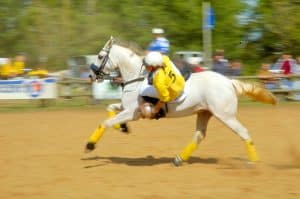Despite its British name, horse-ball is a French invention that has become one of the most popular equestrian team games. Combining the pleasure of galloping with rugby’s taste for contact, the precision of shooting and the aerial passing skills of basketball, they developed a game of equestrian ball. To avoid the arduous acrobatics performed by old-fashioned troopers when picking up the ball, they first enclosed their ball in a hay net, before adopting the principle of a ball with handles from Argentine pato. Taking up the idea of a pre-war general who, to perfect his troops in the art of “land, on horseback”, had them play ball on horseback, a group of friends from south-west France – horse-riding and rugby enthusiasts – invented a game that was to become an equestrian discipline.

Attracted by action, team spirit and a taste for spectacle, many riders were quickly won over by horse-ball and, as with other team sports, attracted loyal teams of supporters in their wake. In 1978, the F.F.E. established official rules and a commission.
Horse-ball today
Today, over 300 junior, senior and women’s teams compete in competitions and championships throughout France. Horse-ball is played on a pitch measuring 20 to 30 meters by 60 to 75 meters. The goals, consisting of a metal circle with a net, are suspended 3.50 meters above the ground. With such dimensions, the intensity of the game is guaranteed, and the public really get the impression of being at the heart of the fray!
Teams are made up of four riders, plus two substitutes. Teams change sides at half-time, which lasts just three minutes. A referee on horseback and two judges on foot ensure that the game runs smoothly.
How a game of Horse-Ball is played
Riders wear simple equipment: riding breeches, knee pads and a jersey in the team colors. A helmet with chin strap is compulsory. As for horse harnessing, except for the fixed martingale, the use of girths is forbidden. Mouthpieces may be chosen freely. The horse’s limbs must be protected.
Picking up, marking, and snatching: three words that attest to the intense animation that reigns during a game. For both surprising dodges and serious contact, in which all aggression is banished, the speed and maneuverability of the horses are as important as the equestrian technique and vigor of the players. Passes can be made in any direction, but a player may not hold on to the ball for more than ten seconds, or risk incurring a penalty. Fitted with six leather handles, the ball can be thrown and recovered with one or two hands, but to snatch it from the opponent, the attacker must use only one hand, without holding on to or leaning on any part of the harness or mount. Thanks to a strap connecting the stirrups under the horse’s belly, players can perform spectacular acrobatics when picking up the ball from the ground, and easily return to the saddle. The ball is picked up from the right or left, without ever putting a foot on the ground and never standing still. When marking, only the horse’s weight and momentum are used. Players must keep their elbows to their body and only press their opponent with their shoulder or arm. With the “three-pass rule”, there are no time-outs in a horse-ball game: for a goal to be accepted, it must be preceded by a minimum of three passes between at least three players on the same team.


